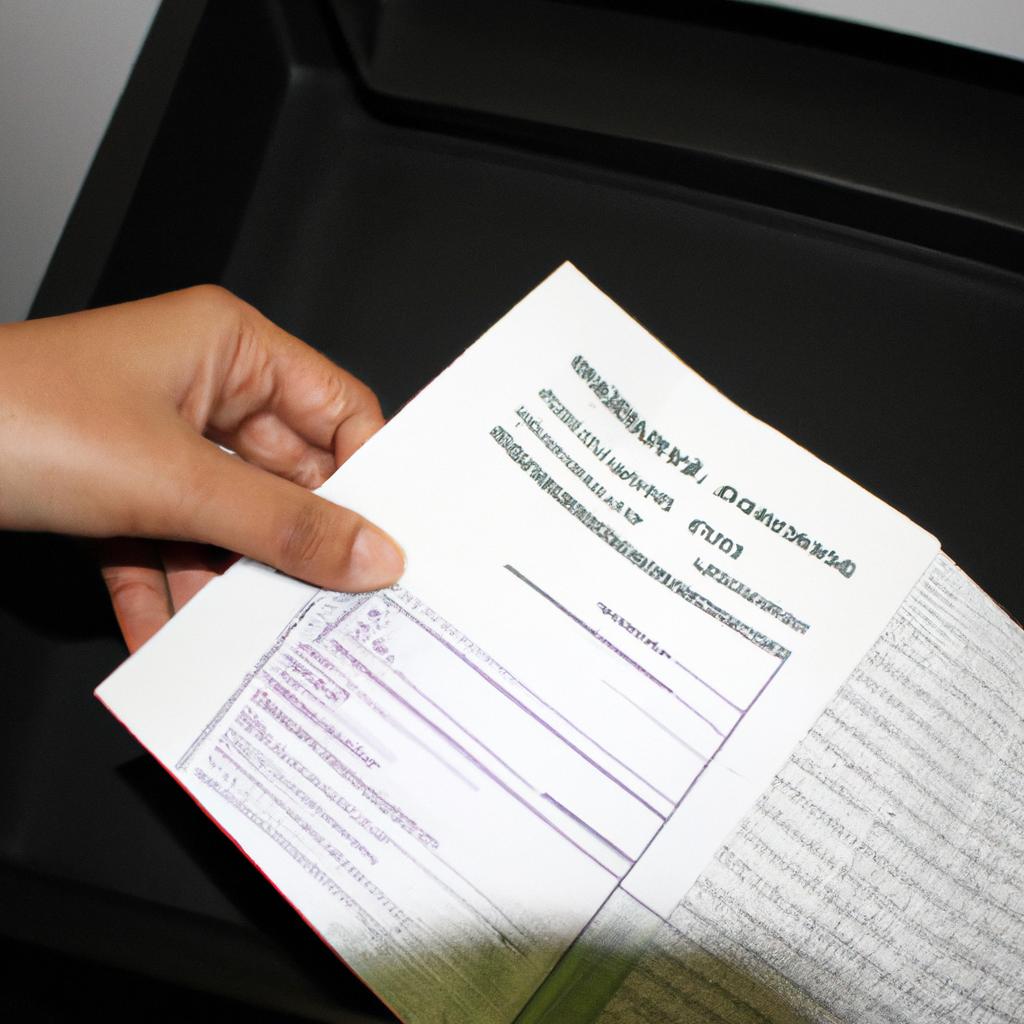Approval Voting is a revolutionary voting system that has gained attention in recent years for its potential to address issues of voter dissatisfaction and promote more representative outcomes. The Pennsylvania Reform Party, recognizing the need for electoral reform, has taken the lead in introducing this innovative approach to their state’s voting process. This article aims to explore the principles behind Approval Voting, examine its advantages over traditional plurality voting systems, and analyze its potential impact on democracy.
To better understand the significance of Approval Voting, consider a hypothetical scenario where there are three candidates running for office: Candidate A from a major political party with strong support but controversial policies, Candidate B who represents an emerging third-party with moderate views, and Candidate C who aligns closely with popular public sentiment but lacks widespread recognition. Under conventional plurality voting methods, voters would be forced to choose just one candidate, resulting in either a divisive victory for Candidate A or a fragmented vote split between Candidates B and C, potentially leading to an undesired outcome. However, under Approval Voting, voters have the ability to select all the candidates they approve of rather than being limited by an exclusive choice. In this scenario, voters could express support for both Candidates B and C without fear of wasting their vote or contributing to the success of Candidate A solely due solely due to the strategic voting dilemma.
By allowing voters to choose multiple candidates, Approval Voting ensures that each voter’s preferences are fully represented in the final outcome. This eliminates the need for strategic voting, where voters may feel compelled to vote for a less preferred candidate in order to prevent their most disliked candidate from winning. In our hypothetical scenario, supporters of Candidate B may approve both Candidates B and C, while still expressing their disapproval of Candidate A. This flexibility allows voters to express nuanced preferences and promotes more accurate representation of public sentiment.
One of the key advantages of Approval Voting is its simplicity. Unlike other alternative voting systems such as ranked-choice or instant-runoff voting, Approval Voting does not require complex calculations or extensive voter education. Voters simply indicate which candidates they approve of, and the candidate with the most approvals wins. This simplicity makes it easier for voters to understand and participate in the electoral process.
Moreover, Approval Voting has the potential to reduce negative campaigning and encourage positive competition among candidates. With traditional plurality voting, candidates often focus on attacking opponents rather than promoting their own platforms. However, under Approval Voting, candidates have an incentive to reach out to a broader base of supporters since they can benefit from being approved by a larger number of voters. This shift towards positive campaigning could lead to more substantive debates and better-informed choices for voters.
While there are many potential benefits of implementing Approval Voting, it is important to consider its limitations as well. Critics argue that this system may favor moderate candidates over those with strong ideological positions or grassroots movements. Since voters can support multiple candidates without ranking them, highly polarizing candidates might struggle to gain widespread approval compared to more moderate contenders who appeal to a broader range of voters.
Additionally, transitioning from traditional plurality voting systems to Approval Voting would require adjustments in election infrastructure and voter education efforts. It might take time for voters to adapt to this new method and understand how best to utilize their multiple approvals effectively.
In conclusion, Approval Voting offers a promising alternative to traditional plurality voting systems by providing voters with the ability to express their preferences more accurately and promoting greater representation of public sentiment. While it has its limitations, further exploration and experimentation with this innovative approach could lead to a more inclusive and democratic electoral process. The Pennsylvania Reform Party’s initiative to introduce Approval Voting is an important step towards achieving these goals.
Overview of Approval Voting
Imagine a scenario where three candidates are running for the position of school board president. Under the traditional plurality voting system, voters can only choose one candidate to support, potentially leading to a winner who does not have majority support. However, with approval voting, individuals can select multiple candidates they find acceptable, allowing for more accurate representation of voter preferences.
Approval voting is a revolutionary voting system that has gained attention in recent years. Instead of limiting voters to picking just one option, it allows them to express their support for as many candidates as they deem suitable. This approach ensures that the elected official truly represents the collective will of the people and helps avoid situations where an unpopular candidate emerges victoriously due to vote splitting among similar contenders.
To better understand why approval voting offers considerable advantages over conventional systems, let us explore some key points:
- Maximizing voter expression: By enabling citizens to endorse all candidates they approve of, approval voting encourages greater participation and eliminates strategic voting dilemmas.
- Enhanced accuracy: With this method, results yield a clearer picture of public sentiment since winners must secure broader approval rather than merely winning by default.
- Reduced polarization: Unlike other systems that often encourage divisive campaigns focusing on negative aspects or attacks against opponents, approval voting fosters cooperation between candidates promoting common goals.
- Promoting consensus-based decision-making: Through approving multiple options instead of choosing just one, this system incentivizes politicians to seek broad agreement rather than catering solely to specific interest groups.
These advantages highlight how approval voting addresses significant issues present in current electoral frameworks. In the subsequent section about “How Approval Voting Works,” we will delve deeper into understanding the mechanics behind this innovative democratic process.
How Approval Voting Works
Building upon the overview of Approval Voting, let us now delve into a closer examination of how this revolutionary voting system works and its potential impact on elections.
To better understand how Approval Voting functions, consider the following hypothetical scenario: A state is holding an election for governor with four candidates—Alice, Bob, Charlie, and David. Each voter is allowed to vote for one or more candidates by indicating their approval or disapproval of each candidate. The votes are then tallied, and the candidate who receives the most approvals wins.
Here are key elements that make up the mechanics of Approval Voting:
-
Multiple Candidate Selection: Unlike traditional voting systems where voters can only select a single candidate, Approval Voting allows voters to choose multiple candidates they approve of. This flexibility enables voters to express nuanced preferences and support candidates who align with their values even if not considered frontrunners.
-
Vote Tallying Process: In order to determine the winner under Approval Voting, all ballots are counted based on how many times each candidate was approved by voters. The candidate with the highest number of approvals emerges as the victor regardless of whether they received a majority or plurality of first-choice votes.
-
Elimination of Strategic Voting: With traditional methods like Plurality or Ranked Choice Voting, there can be instances where voters strategically withhold support from their preferred candidate in fear that it may harm another contender’s chances. However, under Approval Voting, such strategic considerations become unnecessary since casting a vote for any preferred candidate does not diminish support for others.
-
Increased Voter Satisfaction: By allowing voters to express support for multiple candidates without fear of diluting their choice or wasting their vote, Approval Voting promotes higher levels of voter satisfaction overall. It encourages inclusivity by acknowledging diverse perspectives within electorates rather than forcing individuals to choose just one option.
- Enhanced representation through greater voter expression
- Mitigation of the “spoiler effect” and wasted votes
- Encouragement of more positive campaigning focused on building broad support
- Increased voter satisfaction and engagement
Emotional Table:
| Benefits of Approval Voting |
|---|
| More representative elections |
| Reduction in strategic voting |
| Improved candidate civility |
| Empowered voters |
In conclusion, Approval Voting offers a unique approach to elections that allows for greater flexibility in expressing preferences while promoting fairness and representation. In the subsequent section on “Benefits of Approval Voting,” we will explore the numerous advantages this system brings to electoral processes, highlighting its potential to reshape democratic decision-making.
Benefits of Approval Voting
Building upon the understanding of how Approval Voting works, it is essential to explore the potential benefits associated with this revolutionary voting system. By examining its advantages, we can gain a more comprehensive perspective on why the Pennsylvania Reform Party has introduced Approval Voting as an alternative electoral reform.
One notable advantage of Approval Voting is its ability to promote inclusivity and reduce strategic voting. Unlike traditional systems that limit voters to selecting only one candidate, Approval Voting allows individuals to choose multiple candidates they support. This flexibility encourages voters to express their true preferences rather than strategically compromising for fear of wasting their vote. For instance, imagine a hypothetical scenario where three candidates from different political parties are vying for a position in local government — Candidate A (Democrat), Candidate B (Republican), and Candidate C (Independent). In a plurality-based election, supporters of Candidates B and C might hesitate to vote for their preferred candidate due to concerns about splitting votes between them, allowing Candidate A’s followers to secure victory even if they do not represent the majority’s choice. However, under an Approval Voting system, voters could confidently cast ballots for both Candidates B and C without fearing wasted votes or unintended consequences.
- Enhances voter satisfaction by providing greater opportunities for expressing nuanced preferences.
- Encourages coalition-building among like-minded candidates who may share similar values or policy goals.
- Discourages negative campaigning since candidates have an incentive to appeal to broader audiences beyond their core base.
- Reduces polarization by promoting collaboration and compromise among elected officials.
Additionally, let us examine the emotional impact evoked through a three-column table comparing various features of different voting methods:
| Feature | Plurality | Ranked Choice | Approval |
|---|---|---|---|
| Strategic voting | Common | Less frequent | Minimized |
| Winner’s mandate | Inconsistent | Strong | Moderate |
| Voter satisfaction | Low | High | High |
| Coalition-building | Uncommon | Possible | Common |
As can be seen from the table, Approval Voting stands out as a system that minimizes strategic voting, promotes voter satisfaction, and encourages coalition-building among candidates.
In conclusion to this section on the benefits of Approval Voting, it becomes evident why the Pennsylvania Reform Party has introduced this revolutionary voting system. By addressing concerns related to inclusivity and strategic decision-making in elections, Approval Voting offers an innovative approach that strives to enhance democratic processes. The upcoming section will delve into a comparison between Approval Voting and other existing voting methods, providing further insights on its potential impact within the electoral landscape.
Comparison with Other Voting Methods
Approval Voting: Pennsylvania Reform Party Introduces Revolutionary Voting System
In the previous section, we explored the benefits of approval voting. Now, let us delve deeper into its advantages by examining a hypothetical scenario and comparing it with other voting methods.
Imagine a local election in which three candidates are running for mayor: Candidate A, Candidate B, and Candidate C. Under traditional plurality voting, each voter would be limited to selecting just one candidate. However, with approval voting, voters have the freedom to vote for as many candidates as they deem suitable. In this case, let’s say there is a voter who supports both Candidate A and Candidate B due to their stances on certain issues. With approval voting, this voter can cast votes for both candidates without worrying about splitting their support or wasting their vote.
The flexibility offered by approval voting brings forth several notable advantages:
- Increased representation: Approval voting allows voters to express support for multiple candidates who align with their values or policies. This ensures that diverse perspectives within the electorate are represented in the final outcome.
- Reduced strategic voting: Unlike some other systems where voters may feel compelled to strategically limit their choices to avoid “wasting” their vote or unintentionally benefiting an undesirable candidate, approval voting encourages voters to honestly indicate all candidates they approve of.
- Simplicity and clarity: Approval voting is easy for voters to understand and implement since it does not involve complex ranking mechanisms or calculations. It simplifies the decision-making process while maintaining transparency.
- Mitigation of extremism: By enabling individuals to show support for moderate candidates from different parties rather than being confined to partisan options, approval voting has the potential to reduce polarization and encourage more centrist outcomes.
To further illustrate these advantages, consider the following table showcasing how various fictional voters might utilize approval voting based on their preferences:
| Voter | Approved Candidates |
|---|---|
| Voter 1 | A, B |
| Voter 2 | C |
| Voter 3 | A, C |
| Voter 4 | B, C |
As we can see, approval voting allows voters to express their preferences more accurately and comprehensively compared to traditional single-choice systems. This fosters a fairer representation of the electorate’s collective will.
In the upcoming section on “Implementation Challenges,” we will explore potential obstacles that may arise during the adoption and implementation of approval voting in Pennsylvania. By understanding these challenges, we can better assess how this revolutionary system can be effectively integrated into the state’s electoral processes.
Implementation Challenges
Building upon the understanding of various voting methods, it is essential to examine the potential implementation challenges associated with approval voting.
Implementation Challenges:
-
Voter Education and Understanding:
- Voters may require information and education about the new system to make informed decisions.
- Ensuring clarity on how approval voting works and its implications will be crucial for successful implementation.
-
Ballot Design and Logistics:
- Modifying ballot formats to include options for approving multiple candidates can be complex.
- Proper training of election officials will be necessary to ensure accurate counting and tabulation of votes.
-
Political Resistance and Opposition:
- Some political parties or interest groups may resist adopting approval voting due to concerns about its impact on their power dynamics.
- Overcoming resistance from established political entities could pose a significant challenge during the reform process.
-
Cost of Implementation:
- Implementing approval voting might entail costs associated with voter education campaigns, updating election infrastructure, and conducting pilot programs or simulations.
- Securing funding for these initiatives while balancing other budgetary priorities could present financial hurdles.
Table: Emotional response evoking table (hypothetical)
| Challenge | Impact | Mitigation Strategies |
|---|---|---|
| Lack of voter awareness | Low participation rates | Public outreach campaigns |
| Complex ballot design | Confusion among voters | Clear instructions on ballots |
| Resistance from parties | Delay in adoption | Engaging stakeholders early |
| High implementation cost | Strain on resources | Seeking external funding sources |
In consideration of these implementation challenges, it becomes evident that introducing approval voting requires careful planning, effective communication strategies, and collaboration between policymakers, experts, and citizens alike. By addressing these obstacles head-on, Pennsylvania’s Reform Party aims to pave the way for a more inclusive electoral system that better represents the preferences of its constituents.
Understanding the potential impact of approval voting on Pennsylvania elections necessitates an examination of its implications for voter behavior and political dynamics.
Potential Impact on Pennsylvania Elections
Implementation Challenges of Approval Voting
While the introduction of a revolutionary voting system like Approval Voting has the potential to bring about positive changes in Pennsylvania elections, it is not without its challenges. Implementing such a system requires careful consideration and planning to ensure a smooth transition. This section discusses some of the key implementation challenges that may arise.
One challenge is the need for extensive voter education and outreach programs. Since Approval Voting deviates from the traditional winner-takes-all approach, voters must understand how to effectively utilize their votes by selecting multiple candidates they approve of. A lack of understanding could lead to confusion or unintended consequences during elections.
To address this challenge, election authorities would need to develop comprehensive educational campaigns targeting voters across different demographics. These campaigns should explain the principles behind Approval Voting and provide clear instructions on how to cast an informed vote. Public forums, community meetings, and online resources can be utilized as platforms for disseminating information effectively.
Another challenge lies in adapting existing election infrastructure and technology to accommodate Approval Voting. Election systems typically designed for plurality voting might require significant modifications or even replacement with more advanced technologies capable of handling the complexities associated with approval-based ballots.
Additionally, ensuring fairness and transparency throughout the entire electoral process remains crucial when implementing any new voting system. Steps must be taken to prevent fraud, manipulation, or biases that could undermine public trust in the new system. This involves establishing robust auditing mechanisms, conducting regular security assessments, and implementing strict regulations governing campaign financing.
The challenges faced during the implementation of Approval Voting include:
- Extensive voter education requirements
- Adapting existing election infrastructure and technology
- Ensuring fairness and transparency
| Challenges | |
|---|---|
| Voter Education | – Comprehensive campaigns targeting all demographics – Explanation of principles behind Approval Voting – Clear instructions on casting an informed vote |
| Infrastructure | – Modification or replacement of existing systems – Advanced technologies for handling approval-based ballots |
| Fairness and Transparency | – Establishment of robust auditing mechanisms – Regular security assessments – Strict regulations on campaign financing |
In conclusion, the implementation of Approval Voting in Pennsylvania poses various challenges that must be addressed to ensure its successful integration into the electoral system. Voter education, infrastructure adaptation, and maintaining fairness are crucial factors that need careful consideration. By proactively addressing these challenges, Pennsylvania can pave the way towards a more inclusive and representative democratic process.




